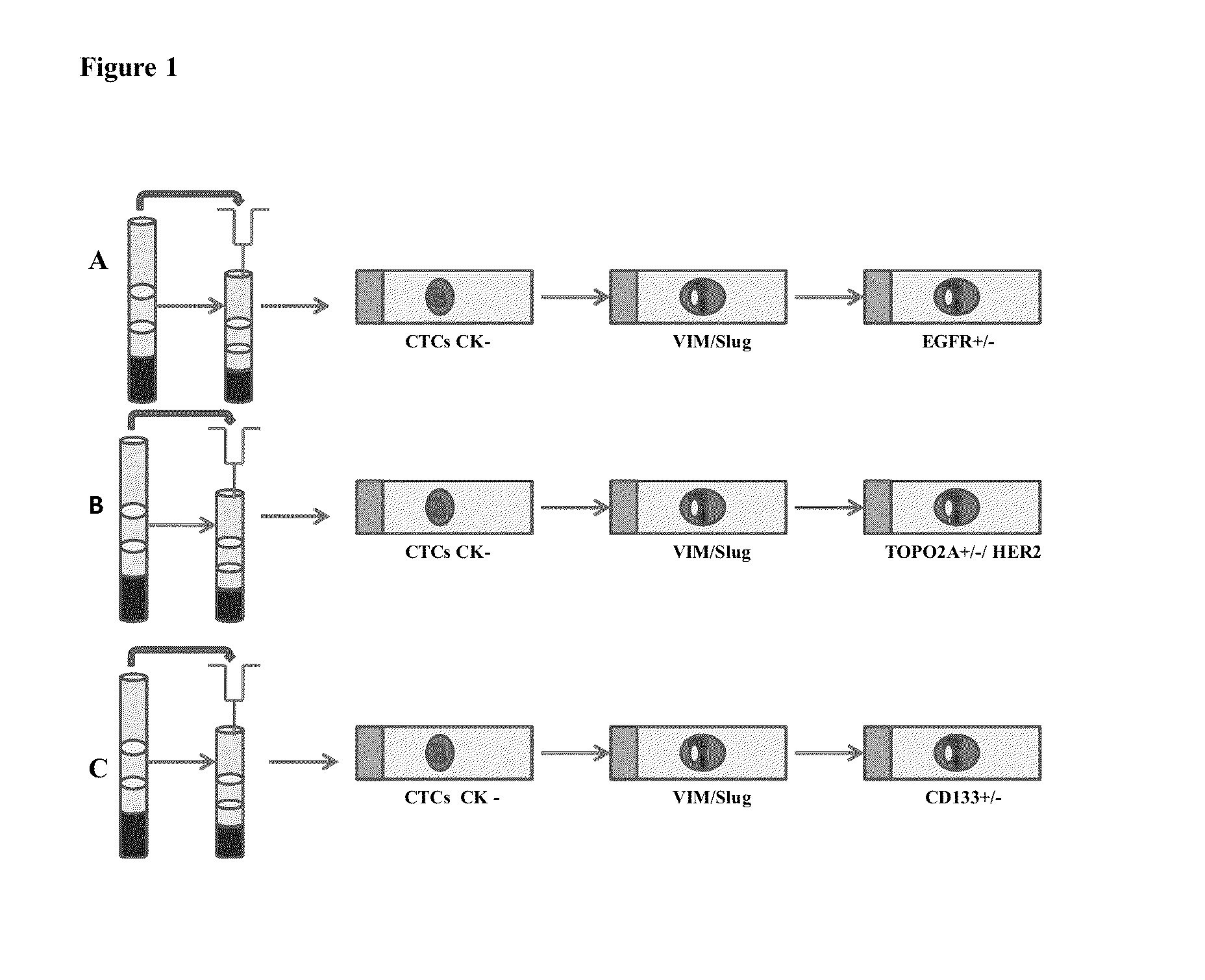Epithelial-mesenchymal transition in circulating tumor cells (CTCS) negatives for cytokeratin (CK) expression in patients with non-metastatic breast cancer
a technology of cytokeratin and tumor cells, applied in the field of cancer, can solve the problems of poor prognosis, high levels of vim expression in cancer patients, and limited knowledge of biological properties of ctcs
- Summary
- Abstract
- Description
- Claims
- Application Information
AI Technical Summary
Benefits of technology
Problems solved by technology
Method used
Image
Examples
example 1
Material and Methods
[0072]1.1. Patients
[0073]Breast cancer patients with stage I to IIIC were identified from the Breast Cancer Unit of the University Hospital of Jaen and Hospital del Mar of Barcelona from March 2009 to September 2010. The inclusion criteria were histological diagnostic of breast cancer with availability of tissue for biomarker studies. The local ethics committee approved this study and eligible patients signed an approved informed consent. Surgical procedure and systemic therapy were given at the discretion of the treating physician with or without targeted therapy, namely trastuzumab for HER2+ breast cancer patients. Medical charts of these patients were reviewed and clinical details were included in a database.
[0074]The inventors used a combination of IHC markers for classification of breast cancer patients based on the pattern of expression of hormonal receptors (HR) and HER2 that identify three major distinct molecular breast cancer subtypes luminal tumors, wh...
example 2
Correlation of VIM and Slug Expression in CTCs with Clinical and Pathological Characteristics
[0097]Patients included in this study were consistent with an unselected early and locally advanced breast cancer population. Clinical-pathological characteristics were stratified according to the baseline VIM and Slug expression in CK-negative CTCs status (Table 1).
TABLE 1Clinical-pathological characteristics according to the baseline statusN(%) VIM+N (%) VIM−p (χ2)N (%) SLUG+N (%) SLUG−p (χ2)Age≦508(33.33)16(66.67)0.2708(30.77)10.305>5010(23.26)33(76.74)9(20)8(69.23)36(80)HistologyDuctal17(29.31)41(70.69)0.25816(25.81)46(74.19)0.309Others1(11.11)8(88.89)1(11.11)8(88.89)Clinical≦2 cm10(31.25)22(68.75)0.048*10(31.25)22(68.75)0.047*Tumor Size>2-5 cm 3(12)2(88)3(10.34)26(89.66) >5 cm5(50)5(50)4(40)6(60)ClinicalN017(29.82)40(70.18)0.18216(26.67)44(73.33)0.196Node StatusN+1(10)9(90%)1(9.09)10(90.91)GradeI2(13.33)13(86.67)0.2242(13.33)13(86.67)0.361II10(37.04)17(62.96)9(32.14)19(67.86)III4(20)16...
example 3
Correlation of VIM and Slug Expression in CK-Negative CTCs with EGFR, CD133, TOPO2 / HER2 Biomarkers
[0099]To test the expression of EMT-like CTCs, 78 blood samples negative for multi-CK-specific markers were processed using CD45 (a leukocyte marker), VIM and Slug (EMT markers) by IF (FIG. 1).
[0100]For VIM analysis, only 67 samples were considered due to a background staining. From these samples, 18 (26.9%) showed VIM expression and 49 (73.1%) were negative. For Slug expression, only 71 samples were considered due to a background staining. 17 (23.9%) of these patients were positives for Slug expression and 54 (76.1%) were negative. Interestingly, when Slug was positive in CK-negative CTCs, VIM marker was co-expressed in 94.4% (17 / 18) of CK-negative CTCs. However, the expression of VIM not always co-expressed with Slug (1 / 18; 5.56%). Thus, VIM negative CTCs were also negative to Slug (49; 100%) (Table 2).
TABLE 2Correlation of Vim and Slug status in Ck-negative CTCsSLUGVIMSLUG− (N) (%)SL...
PUM
| Property | Measurement | Unit |
|---|---|---|
| concentrations | aaaaa | aaaaa |
| concentrations | aaaaa | aaaaa |
| concentrations | aaaaa | aaaaa |
Abstract
Description
Claims
Application Information
 Login to View More
Login to View More - R&D
- Intellectual Property
- Life Sciences
- Materials
- Tech Scout
- Unparalleled Data Quality
- Higher Quality Content
- 60% Fewer Hallucinations
Browse by: Latest US Patents, China's latest patents, Technical Efficacy Thesaurus, Application Domain, Technology Topic, Popular Technical Reports.
© 2025 PatSnap. All rights reserved.Legal|Privacy policy|Modern Slavery Act Transparency Statement|Sitemap|About US| Contact US: help@patsnap.com



